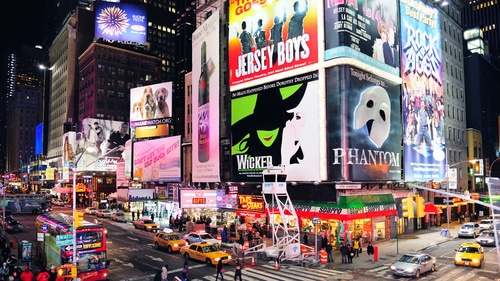Broadway theatre, commonly called Broadway, refers to theatrical performances presented in one of the 40 professional theatres with 500 or more seats located in the Theatre District centered along Broadway, and in Lincoln Center, in Manhattan in New York City. If you are lucky enough to catch a show while visiting the city, or have free time to indulge yourself this is part of the true New York experience. It wasn’t always the Broadway we know today. Here is a brief history of a place that is unforgettable in all our minds. Royal Coachman specializes in creating unique experiences combining our white glove limo service to some of the areas best and brightest shows. We can even customize your experience to include some of the best the holidays have to offer, just give us a call.
Ever wonder where it all started though?
Early New York Theatre
New York did not have a significant theatre presence until about 1750, when actor-managers Walter Murray and Thomas Kean established a resident theatre company at the Theatre on Nassau Street, which held about 280 people. They presented Shakespeare plays and ballad operas . The Revolutionary War suspended theatre in New York but thereafter theatre resumed in 1798. Theatre in New York moved from downtown gradually to midtown beginning around 1850, by 1870 the heart of Broadway was in Union Square, and by the end of the century, many theatres were near Madison Square. Theatres did not arrive in the Times Square area until the early 1900s, and the Broadway theatres did not consolidate there until a large number of theatres were built around the square in the 1920s and 1930s.
Birth of the Musical and Post-Civil War
The first theatre piece that conforms to the modern conception of a musical, adding dance and original music that helped to tell the story, is considered to be The Black Crook, which premiered in New York on September 12, 1866. The production was a staggering five-and-a-half hours long, but despite its length, it ran for a record-breaking 474 performances. The same year, The Black Domino/Between You, Me and the Post was the first show to call itself a “musical comedy.” Tony Pastor opened the first vaudeville theatre one block east of Union Square in 1881 As transportation improved, poverty in New York diminished, and street lighting made for safer travel at night, the number of potential patrons for the growing number of theatres increased enormously. Plays could run longer and still draw in the audiences, leading to better profits and improved production values.
1890s and Later
In the early years of the 20th century, translations of popular late-19th century continental operettas were joined by the “Princess Theatre” shows of the 1910s by writers such as P. G. Wodehouse, Guy Bolton and Harry B. Smith. Victor Herbert, whose work included some intimate musical plays with modern settings as well as his string of famous operettas (The Fortune Teller (1898), Babes in Toyland (1903), Mlle. Modiste (1905), The Red Mill (1906), and Naughty Marietta (1910)). Beginning with The Red Mill, Broadway shows installed electric signs outside the theatres. Since colored bulbs burned out too quickly, white lights were used, and Broadway was nicknamed “The Great White Way.” In August 1919.
The motion picture mounted a challenge to the stage. At first, films were silent and presented only limited competition. Nevertheless, by the end of the 1920s, films like The Jazz Singer could be presented with synchronized sound, and critics wondered if the cinema would replace live theatre altogether. The musicals of the Roaring Twenties, borrowing from vaudeville, music hall and other light entertainments, tended to ignore plot in favor of emphasizing star actors and actresses, big dance routines, and popular songs Broadway theatre entered a golden age with the blockbuster hit Oklahoma!, in 1943, which ran for 2,212 performances. The Tony Awards were established in 1947 to recognize achievement in live American theatre, especially Broadway theatre.
Broadway Today
Both musicals and stage plays on Broadway often rely on casting well-known performers in leading roles to draw larger audiences or bring in new audience members to the theatre. Actors from movies and television are frequently cast for the revivals of Broadway shows or are used to replace actors leaving a cast. There are still, however, performers who are primarily stage actors, spending most of their time “on the boards”, and appearing in television and in screen roles only secondarily.
Most Broadway shows are commercial productions intended to make a profit for the producers and investors (“backers” or “angels”), and therefore have open-ended runs (duration that the production plays), meaning that the length of their presentation is not set beforehand, but depends on critical response, word of mouth, and the effectiveness of the show’s advertising, all of which determine ticket sales. Historically, musicals on Broadway tend to have longer runs than “straight” (i.e. non-musical) plays. On January 9, 2006, The Phantom of the Opera at the Majestic Theatre became the longest running Broadway musical, with 7,486 performances, overtaking Cats.
New York City’s TKTS (pronounced “Tee-Kay Tee-Ess”) is operated by the Theatre Development Fund. There are three locations: one in Duffy Square (at 47th Street and Broadway, the north end of Times Square); another at South Street Seaport in Lower Manhattan (replacing the office formerly located in the lobby of the World Trade Center, which was destroyed in the September 11, 2001 terrorist attacks); and a third in Downtown Brooklyn (Jay St. and Myrtle St. Promenade) The Times Square booth sells day-of-performance tickets only, while the South Street Seaport booth sells tickets to evening performances on the day of the performance and matinee tickets the day before.
Adapted from http://en.wikipedia.org/wiki/Broadway_theatre
Whatever shows you decide to see, give us a call and we can create the one-of-a-kind theater experience you deserve.
Posted in: limo service nj, limousine service new jersey, new jersey events, travel tips
